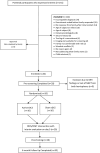Transcranial direct current stimulation and constraint-induced therapy in cerebral palsy: A randomized, blinded, sham-controlled clinical trial
- PMID: 29456128
- PMCID: PMC5899638
- DOI: 10.1016/j.ejpn.2018.02.001
Transcranial direct current stimulation and constraint-induced therapy in cerebral palsy: A randomized, blinded, sham-controlled clinical trial
Abstract
We investigated the safety, feasibility, and efficacy of transcranial direct current stimulation (tDCS) combined with constraint-induced movement therapy (CIMT) in children and young adults with unilateral cerebral palsy. Twenty participants were randomized to receive active or sham tDCS. The intervention consisted of 10 consecutive weekday sessions of tDCS applied to the non-lesioned hemisphere (20 min) concurrently with CIMT (120 min). Participants, caregivers, and interventionists were blinded to group assignment. The primary safety outcome investigated adverse events. The primary behavioral outcome was the Assisting Hand Assessment. All 20 participants (mean age = 12.7 yrs, range = 7.4-21.6 years) were evaluated for the primary outcomes. No serious adverse events occurred, and the most commonly reported minor adverse events were headache and itchiness. Both groups demonstrated a significant improvement in hand function after the intervention, although no significant effect of tDCS was observed (between-group difference = -2.18, 95% CI = [-6.48, 2.12], p = 0.30). Although hand function improved overall, no significant differences between intervention groups were found. Children with preserved corticospinal tract circuitry from the lesioned hemisphere, compared to those without, showed greater improvement in hand function (mean difference = 3.04, 95% CI = [-0.64, 6.72], p = 0.099). Our study demonstrates the safety and feasibility of serial sessions of tDCS, and presents preliminary evidence for the effect of CST circuitry on outcomes following tDCS/CIMT. Future work in children with unilateral cerebral palsy should focus on the optimal dosing and consider individual brain circuitry when describing response to combined interventions.
Clinical trials registration: Clinicaltrials.govNCT 02250092.
Keywords: Constraint-induced movement therapy; Rehabilitation; Transcranial direct current stimulation; Unilateral cerebral palsy.
Copyright © 2018 European Paediatric Neurology Society. Published by Elsevier Ltd. All rights reserved.
Figures






References
-
- Bolognini N, Vallar G, Casati C, Latif LA, El-Nazer R, Williams J, et al. Neurophysiological and behavioral effects of tDCS combined with constraint-induced movement therapy in poststroke patients. Neurorehabil Neural Repair. 2011;25(9):819–29. - PubMed
-
- Figlewski K, Blicher JU, Mortensen J, Severinsen KE, Nielsen JF, Andersen H. Transcranial Direct Current Stimulation Potentiates Improvements in Functional Ability in Patients With Chronic Stroke Receiving Constraint-Induced Movement Therapy. Stroke. 2017;48(1):229–32. - PubMed
-
- Williams JA, Pascual-Leone A, Fregni F. Interhemispheric modulation induced by cortical stimulation and motor training. Phys Ther. 2010;90(3):398–410. - PubMed
Publication types
MeSH terms
Grants and funding
LinkOut - more resources
Full Text Sources
Other Literature Sources
Medical

